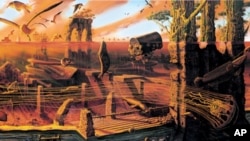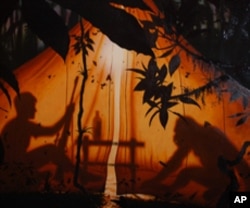One of the first contemporary artists to address subjects such as biodiversity and global warming was Alexis Rockman. The Smithsonian American Art Museum has organized the artist's first retrospective.
With images of tropical plants, insects and amphibians on the walls, it is clear that Rockman has a love of nature but his artist's eye is drawn less to nature's beauty and more to its oddities.
"I think frogs are charming and magical and wonderful, and turtles," the artist says, adding he is "attracted to things that are unlovable."
Inspired by natural history
His paintings feature the type of animals one might encounter in a natural history museum, which isn't surprising.
"His mother worked at the American Museum of Natural History for many years," says curator Joanna Marsh. "As a boy he spent many hours in that museum absorbing the displays, the wall murals."
That clearly can be seen in many of Rockman's early works, especially his monumental 1992 painting, "Evolution," a fantasy landscape of imagined and real animals past and present.
"I started out thinking of it as a chart," Rockman says. "That is generally how I organize information. It starts out as a series, a list of names or things that might happen. And then it is like decorating a Christmas tree really."
A trip to Guyana in 1994 inspired works that were closer to scientific paintings of flora and fauna that he saw in the rainforest. But by the time he returned from that trip, his focus was on man's impact on nature. "I started to think about my feelings for the things I was painting and started to feel active and dynamic."
Sometimes he uses humor to make a point. "Ready to Rumble" shows a trio of masked animals at a landfill. "I was for some reason in the mood to do something a little more lighthearted, so I turned a turkey vulture, a Norway rat and a domestic cat into these characters," Rockman says. "I saw them as superheroes of the dump."
Other times, his approach is a little more subtle, as it is in "The Conversation," which depicts a meeting between modern man and an ancient ancestor, Australopithecine. The figures, seated in a tent are in shadow, but it's clear the contemporary figure is holding a rifle. "It's about hunting and hoping the protagonist will do the right thing."
His message is bleak and clear in a work he started in 2000 and completed nearly four years later - the 7-plus-meter long mural titled "Manifest Destiny." The painting depicts the Brooklyn waterfront 300 years in the future. There is no sign of humanity, but plenty of marine life swimming in the ruins of two bridges and seagulls flying overhead against an orange sky.
Focus on climate change
Curator Joanna Marsh says the mural is one of Rockman's first paintings to focus specifically on climate change. More followed, including a series of iconic American landscapes like the U.S. Capital, the Hollywood sign and the Presidential portraits at Mount Rushmore, impacted by climate change.
It was his treatment of climate change that led to the exhibition title, "A Fable for Tomorrow." Marsh says she borrowed it from the opening chapter of environmentalist Rachel Carson's groundbreaking book, Silent Spring. "She describes a mythic town, 'where all life seems to live in harmony,' and I am quoting Carson. But over time, as the result of chemical pesticides the town shows signs of death."
Carson based her predictions on scientific information, which "is exactly what I saw Alexis Rockman doing in his work," the curator says.
Rockman says the older he gets the more skeptical he is about whether humans will solve the problem before it is too late. "Life isn't going anywhere. It is where humans want to be in the configuration that is up to the humans."
But he says the exhibition at the Smithsonian American Art museum gives him hope. "Because it shows there is a level of consciousness and a willingness to put challenging work on the walls of a governmental institution."
The exhibit covers 24 years of Rockman's career. At just 48 years old, he has many more years to challenge people with his art.
















